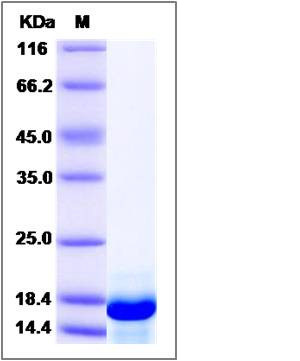Human CRIPT / cysteine-rich PDZ-binding Protein (His Tag)
HSPC139,SSMDF
- 100ug (NPP2053) Please inquiry
| Catalog Number | P14560-H07E |
|---|---|
| Organism Species | Human |
| Host | E. coli |
| Synonyms | HSPC139,SSMDF |
| Molecular Weight | The recombinant human CRIPT consists of 116 amino acids and predicts a molecular mass of 13.1 KDa. It migrates as an approximately 17 KDa band in SDS-PAGE under reducing conditions. |
| predicted N | His |
| SDS-PAGE |  |
| Purity | > 90 % as determined by SDS-PAGE |
| Protein Construction | A DNA sequence encoding the mature form of human CRIPT (Q9P021) (Met1-Val101) was expressed with a polyhistide tag at the N-terminus. |
| Bio-activity | |
| Research Area | Neuroscience |Cell Adhesion Proteins |Cytoskeletal Proteins |Microtubules |Tubulin |
| Formulation | Lyophilized from sterile PBS, pH 7.4. 1. Normally 5 % - 8 % trehalose and mannitol are added as protectants before lyophilization. Specific concentrations are included in the hardcopy of COA. |
| Background | CRIPT, also known as cysteine-rich PDZ-binding protein, belongs to the CRIPT family. It interacts with TUBB1. CRIPT also interacts strongly with the PDZ3 domain of members of the DLG4 family. It is involved in the cytoskeletal anchoring of DLG4 in excitatory synapses. CRIPT is highly conserved from mammals to plants and binds selectively to the third PDZ domain (PDZ3) of PSD-95 via its C terminus. n heterologous cells, CRIPT causes a redistribution of PSD-95 to microtubules. In brain, CRIPT colocalizes with PSD-95 in the postsynaptic density and can be coimmunoprecipitated with PSD-95 and tubulin. These findings suggest that CRIPT may regulate PSD-95 interaction with a tubulin-based cytoskeleton in excitatory synapses. |
| Reference |
